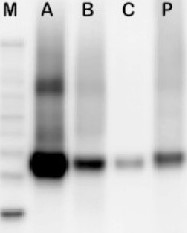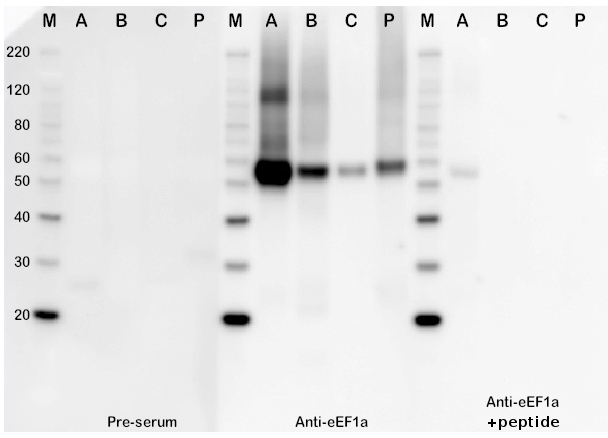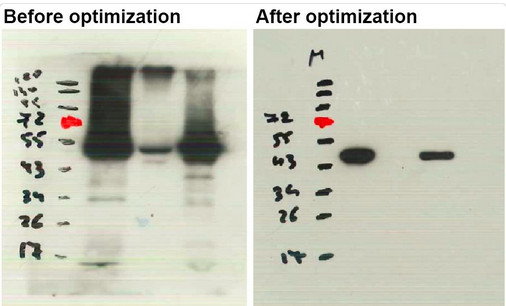1


Anti-eEF1a | Elongation factor 1-alpha
AS10 934 | Clonality: Polyclonal | Host: Rabbit | Reactivity: A. thaliana, A. sativa, H. vulgare, O. europaea, O. sativa,, P.patens. S. tuberosum, Z.mays,
- Product Info
-
Immunogen: KLH-conjugated synthetic peptide derived from known sequences of eEF1a including Arabidopsis thaliana EF-1-alpha 1P0DH99 AT1G07940, EF-1-alpha 2 Q8W4H7 AT1G07930, EF-1-alpha 3 Q0WL5 AT1G07920, EF-1-alpha 4 Q8GTY0 AT5G6039
Host: Rabbit Clonality: Polyclonal Purity: Serum Format: Lyophilized Quantity: 50 µl Reconstitution: For reconstitution add 50 µl of sterile water Storage: Store lyophilized/reconstituted at -20°C; once reconstituted make aliquots to avoid repeated freeze-thaw cycles. Please remember to spin the tubes briefly prior to opening them to avoid any losses that might occur from material adhering to the cap or sides of the tube. Tested applications: Western blot (WB) Recommended dilution: 1 : 1000 (WB) Expected | apparent MW: 49.5 kDa - Reactivity
-
Confirmed reactivity: Arabidopsis thaliana, Avena sativa, Fraxinus pennsylvanica, Hordeum vulgare, Olea europaea, Oryza sativa, Physcomitrium patens, Solanum tuberosum, Zea mays Predicted reactivity: Daucus carota, Euglena gracilis (and unicellular flagellate protists) , Glycine max, Lilium longiflorum, Malus domestica, Nicotiana tabacum, Pisum sativum, Solanum lycopersicum, Triticum aestivum, Vicia faba
Species of your interest not listed? Contact usNot reactive in: No confirmed exceptions from predicted reactivity are currently known - Application Examples
-
Aapplication example

Solanum tuberosum - 20 µg total protein extracted with Agrisera 4xPEB buffer (1), Solanum tuberosum - 20 µg total protein extracted with 50mM Tris and precipitated after with 10%TCA/acetone, the protein pellet was solubilized in urea/thiourea/CHAPS (2), Arabidopsis thaliana total protein 20 µg (3). The total soluble protein was extracted by adding 10%TVA/acetone to the grinded plant material and after washing with acetone 80-100 % the protein pellet was solubilized in SDS buffer. Samples were denaturated 5 min/70°C. PAGE and WB: The samples were separated on 10 % SDS-PAGE and blotted for 75 min on nitrocellulose membrane using wet transfer. The blot was blocked with 5 % milk in TBS-0.1%Tween20 overnight at 4°C. The blot was incubated with primary antibody rabbit eEF-1a at a dilution 1:1000 (before optimization) or 1: 10 000 (after optimization) in TBS-T for 1h/RT with agitation. The Ab solution was decanted and the blot was rinsed briefly twice, 1x 15 min, and 3x 5min in TBS-T at RT with agitation. Blot was incubated with the matching secondary Agrisera anti-rabbit HRP antibody (AS09 602), at a dilution 1:20 000 for 1h with agitation at RT. The blot was washed as above and developed with Agrisera ECL SuperBright. The exposure time was 10 and 15 sec.
5 µg of total protein from Arabidopsis thaliana (A), Hordeum vulgare (B), Zea mays (C), Physcomitrella patens (P) extracted with Agrisera PEB buffer were separated on 4-12 % SDS-PAGE and blotted 70 min to PVDF. Blots were blocked with ECL Advance Blocking Reagent (GE Healthcare) for 1h at room temperature (RT) with agitation. Blot was incubated for 1 h with either rabbit pre-serum (1: 10 000), rabbit anti-eEF1alpha antibody (1: 10 000) and anti-eEF1 alpha serum incubated with eEF1alpha synthetic peptide (in 100 mM excess to saturate a signal from specific antibody) for 1h at RT with agitation. The antibody solution was decanted and the blot was rinsed briefly twice, then washed once for 15 min and 3 times for 5 min in TBS-T at RT with agitation. Blot was incubated in secondary antibody (anti-rabbit IgG horse radish peroxidase conjugated, AS09 602, Agrisera ) diluted to 1:50 000 in for 1h at RT with agitation. The blot was washed as above and developed for 5 min with ECL according to the manufacturers instructions. Exposure time was 2 minutes.
Courtesy Dr. Yordan Muhovski, Centre wallon de Recherches Agronomiques, Belgium - Additional Information
-
Additional information (application): This product can be sold containing ProClin if requested.
Following protein resolubilization with urea/thiourea/CHAPS signal strength of recognized band is decreased. Recommended protein extraction conditions are without urea. - Background
-
Background: EF1A (elongation factor 1-alpha) belongs to the GTP-binding elongation factor family and is localized in the cytoplasm. It is an essential enzyme in elongation phase of protein synthesis. There are four genes encoding EF1A in Arabidopsis, sequences of genes 1,2 and 3 are identical. Synonymes:eEF-1A.
- Product Citations
-
Selected references: Sun et al. (2025). The bZIP transcription factor RISBZ1 balances grain filling and ER stress response in rice grains. Plant Commun . 2025 Jul 17:101458. doi: 10.1016/j.xplc.2025.101458.
Yan et al. (2024). SUBSTANDARD STARCH GRAIN7 regulates starch grain size and endosperm development in rice. Plant Biotechnol J. 2024 Aug 24. doi: 10.1111/pbi.14444.
Yan et al. (2023). OsSHMT4 Is Required for Synthesis of Rice Storage Protein and Storage Organelle Formation in Endosperm Cells. Plants 2024, 13(1), 81; https://doi.org/10.3390/plants13010081,
Pan et al. (2021) Post-Golgi Trafficking of Rice Storage Proteins Requires the Small GTPase Rab7 Activation Complex MON1-CCZ1, Plant Physiology, 2021;, kiab175, https://doi.org/10.1093/plphys/kiab175
Ren et al. (2020). GPA5 Encodes a Rab5a Effector Required for Post-Golgi Trafficking of Rice Storage Proteins. Plant Cell. 2020 Jan 16. pii: tpc.00863.2019. doi: 10.1105/tpc.19.00863.
Djukic et al. (2019). Expression of protein synthesis elongation factors in winter wheat and oat in response to heat stress. Journal of Plant Physiology Volume 240, September 2019, 153015.
Foley et al. (2017). A Global View of RNA-Protein Interactions Identifies Post-transcriptional Regulators of Root Hair Cell Fate.Dev Cell. 2017 Apr 24;41(2):204-220.e5. doi: 10.1016/j.devcel.2017.03.018. - Protocols
-
Agrisera Western Blot protocol and video tutorials
Protocols to work with plant and algal protein extracts
Agrisera Educational Posters Collection
- Reviews:
-
This product doesn't have any reviews.


